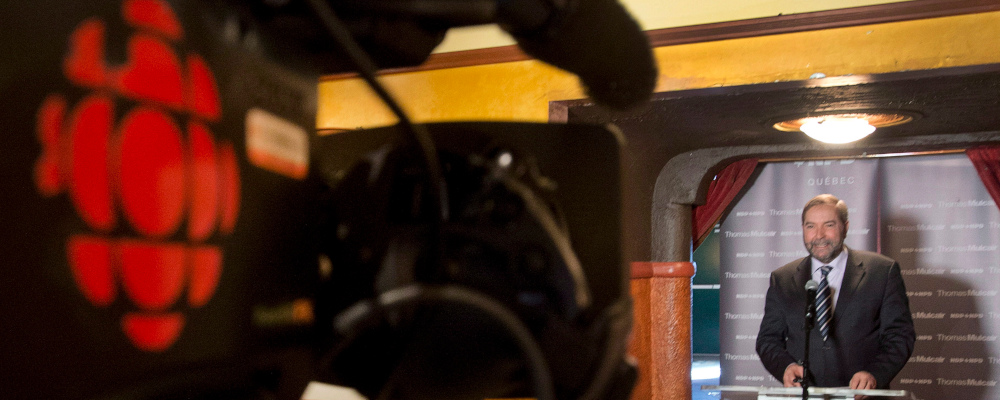The news media in Canada is in crisis. Policy responses to date are failing to solve for the information that citizens need to make informed decisions about important issues and debates. The Future of News series brings together leading practitioners, scholars, and thinkers to imagine new business models, policy responses, and journalistic content that can support a dynamic future for news in Canada.
In November’s Economic and Fiscal Update, Deputy Prime Minister Chrystia Freeland threw Canada’s legacy print media companies a lifeline.
Responding to industry representations, Freeland’s statement included $129 million for eligible news organizations by significantly increasing the Canadian Journalism Labour Tax Credit, allowing publishers to claim up to $29,750 for each journalist in their employ. The initial tax credit was introduced in 2019 to help stem the depopulation of the nation’s newsrooms. The policy immediately drew sharp criticism from the official Opposition, from the public, and from working journalists themselves.
The Conservative Party has continued to oppose these measures including November’s announcement that they’d be expanded, on the grounds that they represent a blatant attempt by the Trudeau government to buy good press. “Any wonder why the Press gallery has been in full attack mode against Pierre since Trudeau’s Fall Update?” asked a senior advisor to Conservative leader Pierre Poilievre. “He’s giving out another $30,000 per journalist in tax-funded media bailouts. Expect them to do whatever the PMO says.”
This line of attack on the moral and intellectual integrity of the news was echoed in social media posts, to the intense irritation and frustration of many working journalists, including those who cover politics for a living. Globe and Mail columnist Andrew Coyne, a model of consistency on the issue who has been as sharply critical of the industry as he has been of the government, posted his “thanks to the prime minister and the publishers for putting us all in this invidious position.”
Under the provisions of the Online News Act, Ottawa has also reached an agreement with Google that will pay $100 million a year, indexed to inflation, to eligible Canadian news organizations including broadcasters, local newspapers, and Indigenous and francophone newsgroups. The distribution of these funds is still unclear.
The business side of the news business has welcomed both pieces of news. On the labour tax credit, Paul Deegan, president and chief executive officer of News Media Canada, said, “Local news is vital, and this targeted investment is both timely and necessary.”
Deegan’s organization speaks for some 575 “titles” across Canada, including the Globe and Mail, La Presse, and Postmedia. One might wonder why a paper like the Globe, owned by one of the world’s richest men, needs or would want government support. Funding for Postmedia is seen as a handout to the U.S.-based hedge fund managers who control the company. Deegan, properly, draws attention to the smaller “titles,” the local and community newspapers that provide the “iron core” of information that is foundational to a citizen’s understanding of the community, the country, and the world.
What is news?
Deegan’s defence is predicated on a core belief that the news is integral in any liberal democracy. That the media is a primary site of political discourse. That media provides much of the vernacular for public debate. That media matters. That as journalism goes, so goes democracy. Which raises two fundamental questions: how “goes” journalism today? And is “news” currently defined as foundational to political discourse and public engagement as conventional wisdom holds?
Wilbur Schramm, a scholar and authority on mass media, described news as “an attempt to reconstruct the essential framework of an event.”
News is also an account of what is different today from yesterday. News is about the exception. News isn’t about what works, news is about what doesn’t. For that reason, Harvard professor Thomas Patterson says news is essentially anti-government, not because of a philosophical or partisan bias as political operatives tend to believe, but because of the very definition of news.
The Canada Emergency Response Benefit is a case in point. CERB was designed to provide financial support to employed and self-employed Canadians directly impacted by the COVID-19 pandemic. Literally millions of Canadians applied. The application process was relatively easy and largely accessible. There were structural shortcomings to be sure around income thresholds, gender and diversity biases, and the way the program dealt with, or more precisely failed to deal with, migrant and undocumented workers.
Yet the news coverage tended to feature the anecdotal in the individual who didn’t get their cheque or the small business owner who couldn’t meet rent at the end of the month even though the end of the month came literally days after the pandemic was declared. The proverbial “forest”,” the millions of Canadians who received funding within days of applying for relief, was largely overlooked.
The playbook was obvious. Use an episode to support an assertion about a larger truth—COVID-19 triggered layoffs, for example. Find the person who didn’t get their CERB cheque immediately, use it to make the case the program is flawed, and then position the political leader as either the person who is responsible for the flaw or the political leader who can fix the problem. And years later, when the economic and social threat posed by the pandemic is diminished, use the benefit of hindsight to argue the government overspent on CERB altogether.
The storyline can find a fresh “news hook” each day by finding another example. The cumulative effect of this type of reportage has an impact, especially if the newsmaker settles on a consonance of language. These “congenial truths,” to borrow a phrase from Nathan Heller, “spread with the authority of gossip or folklore.” And they are foundational for the “system is broken” narrative that has emerged in political discourse in Western liberal democracies. Failures of public policy or political institutions warrant extensive news coverage, but news stories should be the start of the political conversation, not the last word.
The renowned Walter Lippmann argued news and truth are not the same thing, and that the work of reporters is less about bringing light and more akin to a flashlight in a dark room. This “reality” is reinforced by the fact news is about accuracy, not veracity.
Former U.S. President Donald Trump exploited the difference between accuracy and veracity in political coverage. Trump knew journalists would accurately report anything he said whether the utterances bore any resemblance to the truth or not. The resulting news stories were more stenographic than journalistic.
In a bid to distance themselves from the partisan press of the past, legacy media mistakenly left the task of establishing the truth to others.

While the failures of journalism in our current age are obvious, if it is to survive and reassert its place in public discourse, then the media will have to move from the “news” business to the “truth” business. Reporters, as columnist Dan Gillmor put it, don’t have to let liars use them as loudspeakers.
Going forward, media needs a new business model, new journalistic practices, a new product to sell, and new incentives to attract an audience.
Canadian communications scholar Harold Innis first suggested that Western civilization has been profoundly influenced by communications. Innis observed that “with each new communications technology, a new empire emerges that harnesses the innovative power that new media affords.”
This “new empire” has emerged in Canada—and throughout the Western world—without the benefit of an exhaustive public policy discussion on the role of journalism in general, and social media platforms in particular, in our politics.
New York Times columnist Thomas Friedman says we should have had the discussion back in 2007 as now dominant social media platforms were emerging, but we were collectively preoccupied with the global economic crisis, and just as we worked our way through that, we had to deal with the pandemic.
How we got here
News, as we know it, is as much a product of the Industrial Age as a tin can.
An emerging technology of the 19th century—the telegraph—was central to its development. To this day, news stories for print publications tend to be written in what is known as the “inverse pyramid” style. Telegraph lines had a way of going down, those crafting the dispatch couldn’t be certain how much of the text would actually get through. The “lede” approach was developed, and the essence of the story is set out in the opening paragraph.
This technology gave rise to what communications scholar James Carey described as a “transmission model”: the conveyance of information over distance for purposes of control.
This top-down, one-to-many model was effective with newer technologies such as radio. And it was perfect for television, which surpassed newspapers as the information medium of choice in the early 1960s.
Television allowed political leaders to connect directly with low-involvement voters. A “parasocial” relationship ensued, whereby listeners and viewers felt a personal connection to the political leader. Television news, to cite the scholars, was news that mattered. News helped shape the political agenda, determining what problems a leader had to take up and what issues he or she could safely ignore. A limited number of gatekeepers shaped the news.
The television screen was central to this process. Because television tended to be leader-centric, there was a corresponding shift in the balance of political coverage. In Canada, prime ministers and their offices took up much of the media oxygen.
Then the screen changed. To small screens on laptops, iPads, and mobile phones. Innis’ new empire had an immediate and direct impact on the journalistic tradition that reflected Robert Heinlein’s “First Witness.” Political leaders can now connect directly with low-involvement voters through social media and have the option of bypassing the legacy media entirely. One example: the leader’s tour, once central to an election campaign’s earned media strategy, is now an anachronism.
The media’s “gatekeeper function” is now widely shared. V.O. Key’s “echo chambers” have multiplied exponentially. Misinformation and disinformation campaigns are a direct consequence. A 2018 study concluded fake news “diffused significantly further, faster, deeper and more broadly than the truth.”
Harold Laswell’s genius in asserting political communication can be reduced to five questions—who, says what, to whom, through which channel, to what effect?—holds. But the answers to those five questions are dramatically, even radically different.
Much of the current conversation about legacy media begins with the assertion advertising—the midwife of a free press—has moved to the platforms. The eyeballs have followed and they aren’t going to come back for the “news” product currently on offer.
They may come back for journalism, specifically a journalism that embraces James Carey’s “philosophy of inquiry,” reportage that provides context, that gives meaning.
Truth is cumulative, truth is a process. The first word may or may not be the last word. The “news” stated the Israeli defence forces bombed a hospital in Gaza—until it was proven they didn’t. And a fatal, fiery explosion on the Rainbow Bridge in Niagara Falls was erroneously described in at least one news report as a terrorist act. Andrew MacDougall, former director of communications for then prime minister Stephen Harper, took to X in a wistful post, “Imagine a world where people would take the time to check information—for truth and accuracy—before they distributed it.” MacDougall’s conclusion: “This is why we need journalism, folks.”
The Canadian Broadcasting Corporation’s English Services could lead the pivot to a different kind of journalistic offering. The CBC has more reach and journalistic resources at its disposal than any other news organization in the country. As a public broadcaster, a focus on people and their problems rather than on politicians and theirs is consistent with its mandate. And to be blunt, CBC News and Current Affairs don’t really have anything to lose. CBC Radio has enjoyed significant success because its programming reflects the diversity of Canada’s conversation, in the arts, science, business, books, and, yes, politics. Poilievre has promised to defund the CBC if his Conservatives win the next federal election. Poilievre and his political advisers have clearly decided there is more opportunity than risk in the campaign promise. The fact alarmingly fewer people now watch “The National,” the CBC’s flagship news vehicle, is undoubtedly a factor in Poilievre’s thinking.

Practical policies to help the industry evolve
Patterson describes journalists as society’s “chief sense makers” and journalism as a “sorting out process.” Academic research confirms social media platforms such as Facebook, YouTube, and TikTok are the go-to sources for news. And social media posts most certainly help shape public opinion. The impact of TikTok on attitudes about the current war in the Middle East is one example. But research also suggests news consumers look to established media platforms when they want the truth.
NYU professor Jay Rosen offers an excellent example of one area where political coverage could and should pivot: reporting on polls. Horse race coverage has long been an element of political journalism and coverage of public opinion polls conducted by reputable opinion research polls is a staple. When the horse race was a once-a-month story around the release of a Gallup Poll, the impact on public opinion was limited. But with the proliferation of political polls, the horse race story is now a weekly, if not more frequent, event, with a consequential impact on public opinion itself. And the expression of public opinion has a direct impact on political journalism. “The media do not just shape what the public is interested in, but also are shaped by it,” states author Danial Kahneman. “Editors cannot ignore the public demand that certain topics and viewpoints receive extensive coverage.” Rosen’s suggestion to political reporters? “Focus on the stakes, and not the odds in the elections.”
Studies have established Canadians aren’t all that inclined to pay for news—middle of the pack in a recent survey of 20 countries—which Carleton professor Dwayne Winseck says suggests a paid news model is not viable on its own.
An incentive may be required.
The easiest to implement would be a dramatic increase in the Digital News Subscription Tax Credit. Now available up to $75 in tax relief, the tax credit’s “incentive” potential is minimal. Raising the credit to levels equal to the treatment of political contributions might provide more stimulus. In Ontario, for example, that would mean raising the value of the credit to as much as $650 at the federal level, and in Ontario, $1,552 at the provincial level.
The subscription tax credit model has several advantages, the most important being the fact it would boost start-ups as much as legacy news organizations. The fact the solution is market-based, with no role for government with a benefit that accrues to the subscriber/taxpayer rather than the news organizations directly enhances the appeal.
Innis noted it is exceedingly difficult for successive generations to understand new institutions. No disrespect intended, but aging boomers running legacy news organizations aren’t likely to figure out the alchemy of a new offering, a different business model, a different professional skill set, and the ever-escalating methods of distribution. If they had an answer, they wouldn’t be beating a path to Ottawa looking for lifelines that look more like life support systems. Freeland’s lifeline to the legacy media can, perhaps, buy the nation’s print publications some time. But it is not an answer. In fact, Freeland would be well advised to use the Spring Budget to introduce a sunset clause for the journalism labour tax credit.
So in an immediate sense, incentives that encourage multiple subscriptions such as The Logic, The Line, The Hub, or Substack columns by writers such as Paul Wells will be more effective over the longer term. A proliferation of startups could also help address some of the imbalances in Canadian journalism. A recent survey of 6,000 journalists conducted by the Canadian Association of Journalists concluded people of colour continue to be vastly under-represented in newsrooms.
There is a need for journalism in the longer term.
A century ago, when communications technologies were just emerging, Walter Lippmann warned there can be no liberty for a community that lacks the information by which to detect lies.
Former Columbia journalism review editor Joan Konner said “The legitimacy of our democracy depends on having everyone participate in our deliberations. The challenge to journalism is how they can help us to construct a democratic conversation.”
The how, according to James Carey, is to set aside the transmission model of communication that has been central to public discourse and embrace a “ritual” model that encourages engagement and conversation; a world, Carey said, where there are no final thoughts, no last word.
The Future of News series is supported by The Hub’s foundation donors and Meta.
Recommended for You

Canadians ‘risk being fired’ for Charlie Kirk assassination justifications and celebrations

‘Now is the perfect opportunity’: What’s the value of the social sciences and humanities in Canada today?

Kelden Formosa: Welcome back to school. Are your kids being taught how to read?

Howard Anglin: The danger of Canada’s domesticated foreign policy




